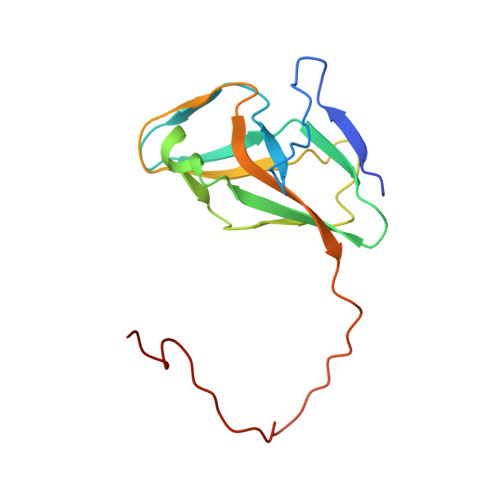Tying Down the Arm in Bacillus Dutpase: Structure and Mechanism
Garcia-Nafria, J., Timm, J., Harrison, C., Turkenburg, J.P., Wilson, K.S.(2013) Acta Crystallogr D Biol Crystallogr 69: 1367
- PubMed: 23897460
- DOI: https://doi.org/10.1107/S090744491300735X
- Primary Citation of Related Structures:
4AO5, 4AOO, 4AOZ, 4APZ, 4B0H - PubMed Abstract:
Homotrimeric dUTPases contain three active sites, each formed by five conserved sequence motifs originating from all three subunits. The essential fifth motif lies in a flexible C-terminal arm which becomes ordered during catalysis and is disordered in most crystal structures. Previously, it has been shown that the two Bacillus subtilis dUTPases, YncF and YosS, differ from their orthologues in the position in the sequence of the essential Phe-lid residue, which stacks against the uracil base, and in the conformation of the general base aspartate, which points away from the active site. Here, three structures of the complex of YncF with dU-PPi-Mg(2+) and the structure of YosS complexed with dUMP are reported. dU-PPi-Mg(2+) triggers the ordering of both the C-terminal arm and a loop (residues 18-26) which is uniquely disordered in the Bacillus dUTPases. The dUMP complex suggests two stages in substrate release. Limited proteolysis experiments allowed those complexes in which C-terminal cleavage is hindered and those in which it can be assumed to be ordered to be identified. The results lead to the suggestion that dUpNHpp is not a perfect substrate mimic, at least for the B. subtilis enzymes, and provide new insights into the mechanism of these two dUTPases in comparison to their orthologues. The enzyme mechanism is reviewed using the present and previous crystal structures as snapshots along the reaction coordinate.
Organizational Affiliation:
Structural Biology Laboratory, Department of Chemistry, University of York, Heslington, York YO10 5DD, England.


















